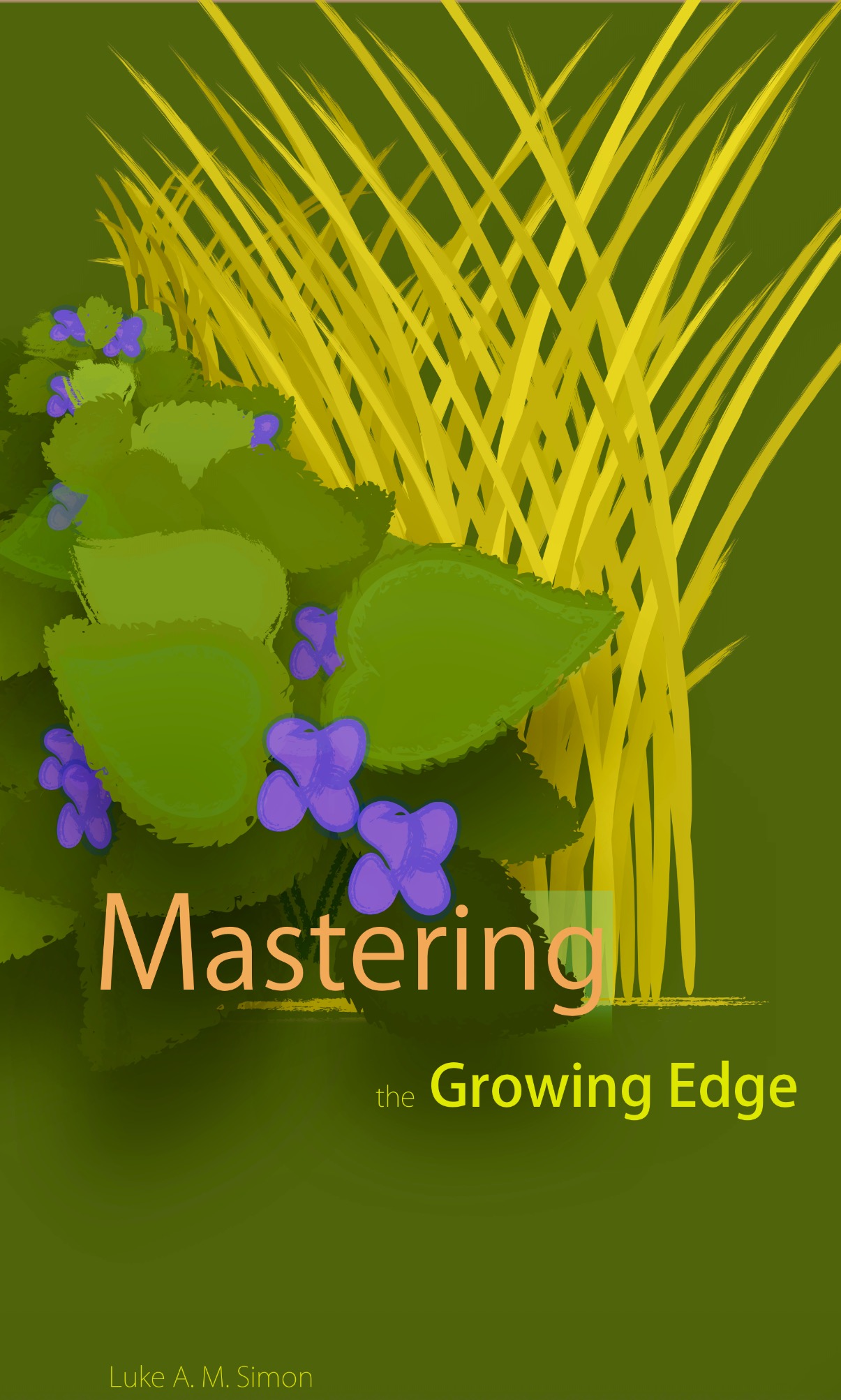I have been helping a friend set up a permaculture system in his yard. He’s put in some apple and cherry trees, black and red raspberries this spring. I helped him plant a blueberry bush last fall. The yard is getting its basic tree structure in place.
We are still dealing with weeds though, especially in part of the back yard where he wants to put the garden. It’s a steep slope that is far to steep to till, or else the whole thing would slosh down the road with the first heavy rain. Worse, before it was clear cut about two years ago, it was a mess of blackberry, mint, rosebush, wild sweet pea, young sassafras and oaks, Canadian thistle, and poison ivy. These are trying to take the place back now.
It’s a battle for sure; a matter of mind, with consistent, carefully thought out actions since, between the steepness of the slope, the ferociousness of the weeds, and a lack of time to devote to the project, brute force might not be the most effective move.
I’ve listed the design requirements as:
- only 3-6 hours of maintenance twice to three times a year aside from harvesting.
- to be completely no-till because the hill is so steep.
- because it is no-till it will need lots of mulch for fertility, moisture retention, and weed eradication. So the system, if it is to be self sustaining, will need to produce a lot of mulch. If not, small amounts of mulch can be brought in from somewhere else.
- Needs to be productive. He’s interested in food, not so much aesthetic effects.
Plan A to get rid of the weeds was cover crops. We cut down the weeds (scant at this time) for mulch, and sow a cover crop in this mulch to choke out the weeds to create fertility, making it easier to grow a lush cover crop to choke out more weeds etc.
Unfortunately plan A backfired with the weeds choking out the cover crop because I couldn’t make it over to his place often enough to keep cutting down the cover crop and weeds to get a new cover crop going. Scratch plan A.
Plan B, which we just executed a couple days ago, was to carbon bomb the place, by mulching heavily with leaves, holding down the leaves with a layer of hay. He rounded up enough leaves from his neighbors and anywhere else he could find them. I provided a small round bale of hay.
To apply, I started by mowing the standing brush with my scythe. Then we spilled leaves all over, making a six inch to one foot thick layer of leaves, finishing with spreading the hay on top. Once the round bale was shrunk down to the size we could easily lift it, we simply rolled it out like a carpet over the leaves. I would show a picture, but unfortunately I didn’t have anything with me to take one. Take my word that it looked very nice when we finished though.
The effect of this ‘Carbon Bomb’ is that all the carbon in the leaves needs nitrogen to break down. They will pull this nitrogen out of the ground beneath them, leaving little, if any, for the plants underneath to grow. Also, the mulch blocks out the sun, which we all know plants need to grow.
I have seen this effect on other gardens when people zealously pour the leaves on, thinking they will get amazing fertility next year, but really zilch fertility next year because even the nutrients that were there before are all bound up to break down the leaves. I’m trying to use this negative effect to my benefit.
In spring, we will rake the leaves up, then put them back down, re-covering plants that try to grow through, putting new leaves from on top in contact with the ground to suck more nitrogen. Eventually we will plant a cover crop of legumes, since they can make their own nitrogen, and once these can establish root systems without weed competition, we’ll start to plant the plants we want. Planting in polycultures so the plants take care of each other to a large degree, the whole place should become a productive, self sustaining system, aside from a little leaves applied every fall in problem spots.
Of course, the garden will be producing for just him, and he won’t need all that space for food production. Not wanting to leave bare space, wanting to make mulch, I’ll include lots of large mulch plants like Comfrey in the design. If they are at the top of the hill, their nutrients will flow down. But we might try arranging them in semicircles below patches of potatoes so when the potatoes are dug, the Comfrey will make sort of a barrier to block the dirt from washing down the hill; and keep the dirt in place because the mulched leaves that will lay on top of the dirt will keep the rain from hitting directly.
I don’t plan that he will cut the mulch plants once a month like I do. They will just be there and grow as much as they want to every year. Besides that, more edible plants that we’ll include in the polycultures will also serve for mulch and nutrient accumulation. Between all these, I think the garden can be largely self mulching.
The project shows promise. I’ll keep you posted on how it grows.




I would love to hear how this worked out. We have about 3 acres completely overrun with multiflora rose, poison ivy, virginia creeper, mugwort and goldenrod. It is partly shaded by about 10yo ash trees that were not mowed in the former orchard rows. We have 3 goats we rotate through with 250ft electronet, but in learning about their mineral needs I am wondering if re mineralizing the soil through amendments, cover crop mixes esp with taproot radish, over a few seasons, would not only choke out the weeds but shift the soil so they no longer thrive there. Curious to hear anyway how this worked.
LikeLike
I’m not sure if you noticed it yet, but this is the latest post on the project. https://mortaltree.wordpress.com/2014/05/22/news-of-half-success/ I have given very little time to it. I have a design for planting written up and ought to just tweak the last few details and give it to him.
It sounds like you have a very advanced system developed in your field. I cringe to think of the mugwort because it makes a potent allelopath I’m told lingers in the soil for a while. Speeding up the biology will doubtless speed the breakdown process of the allelopath though.
Poison ivy would suggest a rather acid soil. So if you’re going to add nutrients I would guess you’d benefit from some lime, but only start applying things after you’ve had a competent soil test done.
Personally I find most soils don’t have an extreme need for nutrients to be brought in. Simple getting the different soil horizons into correct ratio’s by planting things that mine the soil and making a thick organic horizon (mulch on top, which becomes humus) often let’s everything else quickly fall into place. If there are any deficiencies after you’ve eradicated your weeds and built some topsoil, then I might add nutrients.
With all of these plants growing, the many roots systems and the chemicals they are exuding into the soil won’t be very conducive to groundhog radish. It is a real wimp without plentiful nitrogen. I’ve seen several fields and planted many small patches with low nitrogen with groundhog radish, and they barely make a three inch taproot. They do not choke out perennial weeds unless the battle is near over. I might try an annual vetch seeded on to well goat ravished paddocks. If you’re really bold I might try burdock also. Mulching is an option, but it needs to be seriously heavy duty, and applied early in the year. See this post for my latest recommendations on this. https://mortaltree.wordpress.com/2015/01/01/manual-of-bed-building/ I’d be interested to know what you end up doing and what works.
LikeLike
That is such helpful information, thanks. Just one question…I was planning on broadcasting a mix of oats, peas, vetch from Fedco, heavy on peas and about 15% each oats and vetch, the last week of March, in the hopes of getting ahead of the weeds which last year didn’t emerge until early May. I was going to try mowing over the crushed stalks first….or after seeding, but I am concerned about damaging the seed with the tractor, since the only hope really is a low mower will chop them up a bit and drop the seed lower, more likely to get it on the soil. I guess what you’re saying actually makes much more sense, seed the vetch right after the goats go through a patch. Is there any hope of using the early cover crop? Will the vetch germinate that early? I do know of one person who tried for 3 years to eradicate goldenrod permaculture style, he ended up burnimg it. Not sure if I’m ready for that approach.
LikeLike
Broadcasting in early spring when there is frost in the morning and thaw at mid-day, also known as frost seeding, is an effective method. The seed should easily fall low so you can mow and not hurt the seed. All those seeds are early risers and in many climates are best sown in fall to get a head start for the next spring even. An excellent plan all around. Unfortunately you just don’t know your opponent.
Annuals are the startup of a return to forest because they are like the minutemen of the plant world and can appear in a moments notice. They also have relatively simple mechanisms for growth compared to perennials. Perennials, such as golderod, mugwort, poison ivy etc. are designed to move into the system and remove the quick growing annuals. From the bottom up, top down these perennials are designed to be annual killers, having at their disposal complicated chemical allelopaths, far superior root systems that gain energy year by year. They ultimately cycle far more nutrients through much more mass than any annual, creating shade to take the annuals energy, and absorbing the few nutrients available, delivering deleterious effects on the annuals with allelopaths if necessary.
You need to stop the perennial’s cycle, which is to take all the stored energy in their roots and put them into top growth over summer, then take all the nutrients gained back into the soil to make more root mass and hit next year with more nutrients than last. The sign the most nutrients are in the upper part is that the plant blooms. Severely cutting a plant back at flowering often weakens it. This is especially true for goldenrod because it waits until the last minute to bloom and rush back down to its roots. I would recommend cutting them in about July, just between green growth and turning woody, up to flowering. After that the tops aren’t very significant to the plant and you won’t do it much harm.
If you plan on making it food forest though. I would take all this mulch you’re cutting and green limbs from your trees and make very thick mulch –in July or August since you’re mostly working with goldenrod, not grass. Plant the mulch with the mix you mentioned in late fall after the mulch has rotted a bit, and plan on planting it with food forest plants in the spring. Slow progress I know, but very effective in this situation.
Feel free to keep asking questions if that doesn’t make sense. You might check out this post where I explain the field to forest progression theory in a little more detail:https://mortaltree.wordpress.com/2013/06/28/summer-jobs-or-summer-care-for-a-young-food-forest/
As for burning the field, I’ve never tried the technique, so can;t say how effective it would be. From what I have been told the indians often did it during dry spells on prairies. If you could get the field to burn during summer it might have a good effect. Early spring may deliver good effect too if the plants were about 6 inches tall. Let me know if you try.
LikeLike
Ok, this is getting good…so grateful for your perspective and experience. I am not at all in a hurry with 3 young children and 2 cob/bale houses also seeking attention this season! Mostly I am looking for strategies to begin transitioning this section of our land towards productivity. So why shouldn’t I just seed before I mow? Is that the allelopaths still working? Should I plant just vetch and oats, not sure how much field peas will do in late fall here, only rye and vetch are mostly used as late fall covers, I am in zone 5 and sinking with these new more extreme winters. I will definitely add burdock seed…but I imagine I won’t see it until spring, right? We will be harvesting many of the trees this summer and next for building, will I need to use the same wait then cut strategy then, do you think? Or should I be ready in 2016 with early covers then, or seed rye/vetch/burdock in the fall and just let that grow until mid summer, mow, then seed buckwheat or others? Thanks so much for your time and ideas. Btw I did follow up on burning the field, it is Ben Falk from whole systems design in vermont, he said it was a very successful strategy 2 years in, after 3 seasons of trying various cover crop strategies. But he was converting to pasture. I am not ready to try this, and like I said we will be selecting many of the young interspersed trees for timbers so it is premature at best.
LikeLike
Just to clarify that….in 2015 I will try this strategy, moving goats through then mowing mid-late summer, then in the fall either oats/vetch/burdock or sub rye for oats….then in 2016 should I repeat this or will the over-wintered covers come up again? Both summers I anticipate using some of the trees as timbers, so thinning the early forest back to annual/perennial field/food forest will be simultaneous. I may have plants to put in next season or late or early 2017.
Also the burned field was in late april, forgot to mention thst.
LikeLike
You can go with seeding and mowing the field. It will probably take a lot more than two years to get anywhere with this method though. Burdock and vetch will probably be the only two that can take hold. Mowing the perennials when they are vulnerable, as I mentioned, will probably be the best way to help these establish whether you seed in spring or fall. Both burdock and vetch should seed themselves soon. Then you’ll have to deal with them as weeds. But vetch can be mowed at flowering, and be gotten rid of. How long the burdock might persist I’m not sure. Most of them are biennial, so you just have to keep them from seeding in the second year, and then you’re free of them. I’ve seen a few persist for longer though. Of course, the burdock may need to grow for several years before it will take over for you, so maybe that’s a good thing.
Ultimately you would want to mulch and start planting food forest anyway. Since you are going to harvest the trees this year and have a lot of branches, it might be best to just go with the mulch method I mentioned from the start. This won’t convert the whole field, but you would get the best results fastest for the part you did convert to mulch.
Thanks for the info on the burning. I heard Ben was experimenting with it but hadn’t heard what his results were like. I appreciate it.
LikeLike